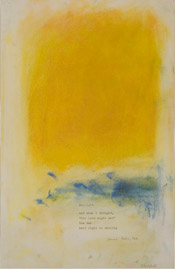Tiger, Tiger: A Few Days with Joan
An artist who went "straight to the mark."
BY Bill Berkson
“You sure had a tiger by the tail!” said a lady by way of commiseration after my talk with Joan at the San Francisco Museum of Art in 1988. “Not me,” I replied, although during the Q&A some members of the audience had been severely burned by her readiness to attack. Joan liked to play rough. “What kind of stupid question is that?!” she demanded of the first one up. She then went on, prompted by I can’t remember what, to expound beautifully on the gists of Hans Hofmann’s classes and their importance for her in the early fifties.
•
Oct. 31 — Frank O’Hara pronounces
John Ashbery “the foremost poet in
English of our time.” Joan Mitchell concurs,
BB grunts, Jean-Paul fixes the camera.
Joan says, “God! How I worked over that poem!
[meaning John’s poem “Europe”]
The listing in the proverbial little black engagements book for 1961 shows Joan and Jean-Paul Riopelle’s Paris residence as 10 rue Frémicourt in the then working-class, now posh 15th arrondissement.
When I first visited there the previous fall, Joan spoke of plastiques exploding nearby, the Algerian militancy being fully active then.
I remember Joan’s studio as enormous, with a long wooden dining
table at one end and much more daylight than her studio on St. Mark’s Place, which always seemed dusky and confining. The occasion
for Joan’s remark about John’s long poem “Europe” was the
appearance in her loft that afternoon of the page proofs of The Tennis Court Oath, its poems written in John’s then-new disjunctive manner.
(She went on that day to specify her sense that “an extraordinary death of culture” was what “Europe” was all about.)
Mostly we met in Frank O’Hara’s company, sometimes in her New York studio with Frank’s apartment mate Joe LeSueur, or in Paris with John Ashbery, Jean-Paul, Frank, and two of Joan’s friends named Mario Garcia and Marc Berlet, or in larger company. Such encounters were few and far between. During our San Francisco reunion, Joan vividly recalled a time sitting on the floor of my mother’s Fifth Avenue apartment with Frank and me, the three of us reading poems aloud to one another. Another instance was at the Closerie des Lilas with Jean-Paul telling us how Francis Picabia in his late years would drive up to the brasserie in one of his big cars, eagerly greeted inside by younger artists as Cher Maître.
•
Joan was the best of the so-called second-generation Abstract
Expressionists. Shortly before I came to Paris in 1963, ARTNews had
featured an article headlined “Is A-E Dead?” Joan had seen it and plainly wasn’t going to let the notion drift by without a fight. She stormed around the studio for a while, trying out with every stride a different intonation of the question, Is A-E dead? Then, having
momentarily gotten that out of her system, she invited me to join her over at the table and, together with offering something in the way of lunch, proceeded, in her lay analyst mode, to ply me with tumblers full of cognac, egging me on to spill every scintillating detail of an ill-fated love affair she had heard I was stuck in. Joan’s intense curiosity about everyone’s private life was something to contend with.
Where Joan and her work are concerned, the close of my introductory remarks that night in San Francisco — the last I ever saw of her — still rings true:
She has led the kind of thoroughgoing artistic life that anyone might dream of, if they dream of being an artist. In her twenties, she went straight to the mark: she quickly became the painter she clearly meant to be. In the company of her peers, she seems always to have been acknowledged as such. In the two major art cities of her time, New York and Paris, she was at the center. Then, moving to Vétheuil, she took her own sense of “center” with her. The other night, Jim Elliot spoke of her “staying power” — the tremendous stamina you see in this show: no slumps, no silent periods, no coasting, no faltering from her particular levelheaded feeling for what painting ought to be. Her early works keep looking more powerful, and the new ones have the same strengths even though they look completely different. That’s as good a dream as anyone is likely to get.
Born in New York in 1939, Bill Berkson was a poet, critic, teacher and sometime curator, who became active in the art and literary worlds in his early twenties. He was professor emeritus at the San Francisco Art Institute, where, between 1984 and 2008, he taught art history, art writing and poetry; Berkson also served as interim dean in 1992 and directed the Letters and Science and public lectures...



